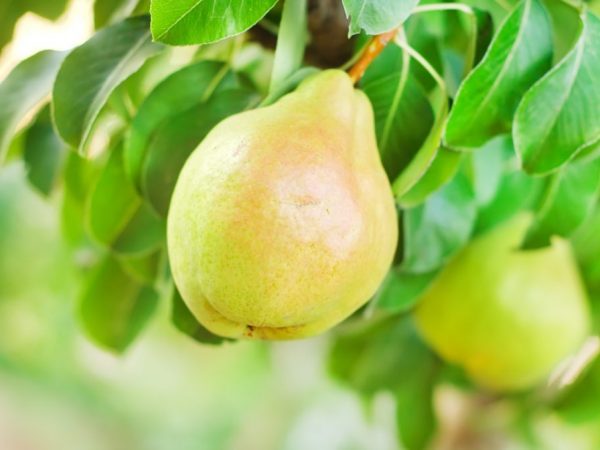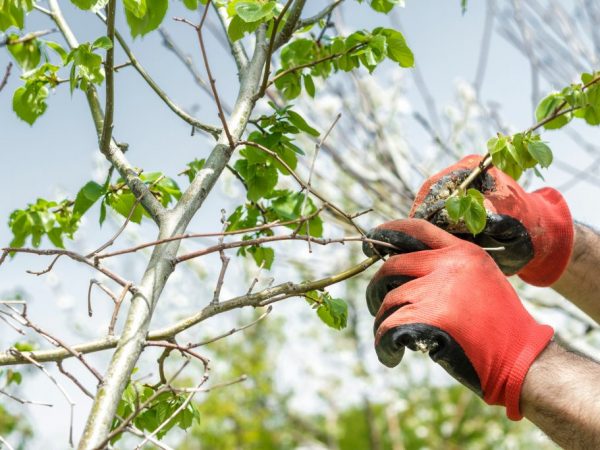Description pear Moskvichka
pear Moskvichka is one of the most famous and demanded autumn varieties. Its name is associated with the place of introduction - the city of Moscow. For a long time it was zoned only in the Moscow region, later - in the Middle Volga, Central and other regions.

Description pear Moskvichka
Characteristics of the variety
The Moskvichka pear variety belongs to the early-growing. The plant will delight you with an abundant and regular harvest annually in September. For the first time, a young tree bears fruit in the third or fourth year of life.
Pollinators for the Moskvichka pear are necessary, since it is self-fertile. The best pollinating varieties are considered Bergamot Moskovsky, Lyubimitsa Yakovleva, Lada.
The description says that the Moskvichka pear belongs to dessert pears. The fruits have an excellent taste, therefore, they are most often consumed raw, and also used to make jams and jams, added to desserts and baked goods, made candied fruits and dried.
The variety has a long shelf life. At a suitable, zero, temperature, pears can be stored for up to 2-3 months, and at room temperature - about two weeks. In addition, ripe fruits do not fall off and can remain on trees for some time, but it is preferable to collect them a week or a half before the moment of full ripening and leave to ripen.
The Muscovite is quite hardy, therefore it is grown in many regions of our country, with the exception of territories with a monsoon or sharply continental climate. Even unfavorable weather conditions are not an obstacle to the ripening of good crops.
Description of the bush
The characteristics of the variety indicate that the adult plants are medium-sized. Young trees have a dense funnel-shaped crown, which becomes conical as it matures and with the onset of fruiting. The bark is gray-brown and the young shoots are brown.
Leaves of medium size are oval in shape. They have a slight bend and jagged edges. They have a deep green color and a smooth surface.
Trees bloom late enough, but beautifully and abundantly. Flowers are small, white, collected in corymbose inflorescences of five to seven pieces.
Description of the fetus
The fruits are practically the same size, their weight ranges between 110-130 grams, but some can weigh about 200-200 grams. They have a slightly sloppy wide pear-shaped shape.

Fruits are yellow-green in color, weight ranges between 110-130 gr
When fully ripe, they are yellowish-green in color with a large number of subcutaneous points and pronounced rustiness. The pulp is white, very juicy. It has a sweet taste with a slight acidity and a pleasant aroma.
Landing
The description of the variety suggests that both the autumn period (early October) and spring (April) are suitable for planting Moskvichka pears. To do this, choose a flat sunny area, with loamy soil or black soil.
A hole is dug in advance: subject to spring planting - in autumn, when planting in October - in 2-3 weeks.It should be about 1 m deep and 80 cm in diameter. The roots of the plant should not bend or break when planting.
The root system of the seedling is soaked in mullein solution a day before planting for better root formation. It is also necessary to prepare a special mixture consisting of the top layer of soil, two buckets of sand, three buckets of compost with the addition of mineral components and 0.5 buckets of organic matter.
A drainage layer (15-20 cm) is placed on the bottom of the pit. Pour the prepared mixture in the form of a hill on top and lower the seedling, leaving the root collar 5-6 cm above the surface. Next, the hole is gradually filled with soil and a wooden peg is driven in near the trunk, to which a tree is tied. The soil near the plant is compacted and abundantly watered with 20-30 liters of water.
Care
Young plants need constant care: timely watering, fertilizing, loosening the soil, pruning.
Watering
Young trees should be regularly watered with 2-3 buckets of water. In the future, the plants need watering at the time of fruit ripening (July-August). It is carried out weekly with 20-25 liters of water under each tree. In heat and dry conditions, moisturize the roots more often. To avoid drying out the soil, mulching is carried out.
Fertilizer
Top dressing begins from the second year of life. They are carried out every year in autumn and spring. In the spring, ammonium nitrate is added to the soil. Also, once every 3 years, plants are fertilized with humus (0.5 buckets) with 50 grams of superphosphate and 20 grams of potassium. In autumn, organic matter (humus) and phosphorus-potassium fertilizers are introduced into the soil.
Pruning
Pruning is carried out in early spring before the start of the movement of juices and bud break. The branches are aligned and all unnecessary shoots are removed. In the first year, the plant should not be allowed to bloom by removing all inflorescences. Sanitary pruning can also be done in the fall.

Pruning is carried out in early spring before the start of the movement of juices and bud break.
Loosening the soil
Loosening is recommended regularly, as it will allow air and water to better penetrate the root system of the plant.
Frost protection
Protection from freezing is especially necessary for young trees. It consists in good mulching the soil for the winter and covering the plants with a special insulating material.
Diseases and pests
The Muscovite is highly resistant to diseases such as scab and fruit rot. But, nevertheless, there are diseases that affect the variety. These include:
- bacterial cancer;
- rust;
- septoria.
To prevent their appearance, in the spring, trees must be sprayed with a urea solution. The treatment consists in three times the treatment of plants with Bordeaux liquid and special preparations, fungicides.
Among insects - pests, it is worth highlighting aphids, sucker and moth. To combat them, insecticides are used.
Conclusion
The Muscovite surprises with its high yield, excellent taste and, at the same time, unpretentiousness. It is thanks to this number of advantages that it has long been one of the most common varieties and has received many positive reviews from gardeners.


